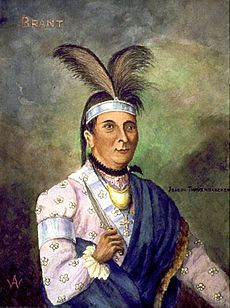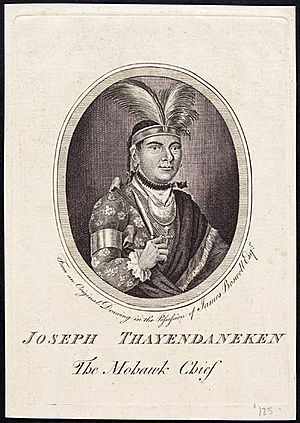Joseph Brant facts for kids
Quick facts for kids
Joseph Brant
Thayendanegea |
|
|---|---|
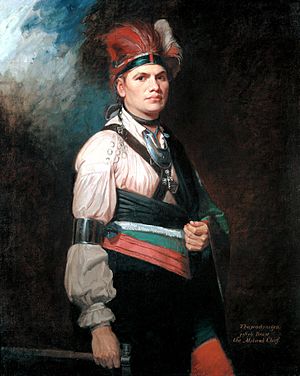
A 1776 portrait of Brant by leading court painter George Romney
|
|
| Born |
Thayendanegea
March 1743 Ohio Country somewhere along the Cuyahoga River
|
| Died | November 24, 1807 (aged 64) Burlington Beach, Upper Canada
|
| Nationality | Mohawk |
| Spouse(s) |
Neggen Aoghyatonghsera
(m. 1765; died 1771)Susanna Aoghyatonghsera
(died) |
| Children | John Brant |
| Relatives | Molly Brant (sister) |
| Signature | |
 |
|
Thayendanegea or Joseph Brant (March 1743 – November 24, 1807) was a Mohawk military and political leader during and after the American Revolution. He met many of the most significant Anglo-American people of the age, including both George Washington and King George III.
During the American Revolutionary War, Brant led Mohawk and colonial Loyalists known as "Brant's Volunteers" against the rebels in a bitter partisan war on the New York frontier. He was accused by the Americans of committing atrocities and given the name "Monster Brant", but the accusations were argued by later historians to have been false.
Contents
Biography
Early years
Joseph was born in the Ohio Country in March 1743, somewhere along the Cuyahoga River. As the Mohawk were a matrilineal culture, he was born into his mother's Wolf Clan.
His parents were Christians and their names were Peter and Margaret Tehonwaghkwangearahkwa. His father died when Joseph was young.
After his father's death, his mother Margaret (Owandah) returned to the province of New York from Ohio with Joseph and his sister Mary (also known as Molly). His mother remarried, and her new husband was known by whites as Barnet or Bernard, which was commonly contracted to Brandt or Brant.
They settled in Canajoharie, a Mohawk village on the Mohawk River, where they had lived before. In the society in which Brant grew up, there was an expectation that he would be a warrior as a man.
The part of the New York frontier where Brant grew up had been settled in the early 18th century by immigrants known as the Palatines, from the Electoral Palatinate in what is now Germany. Relations between the Palatines and Mohawks were friendly. Brant grew up in a multicultural world surrounded by people speaking Mohawk, German, and English.
Brant was described as a teenager as an easy-going and affable man who spent his days wandering around the countryside and forests with his circle of friends, hunting and fishing. During his hunting and fishing expeditions, which lasted for days and sometimes weeks, Brant often stopped by at the homes of Palatine and Scots-Irish settlers to ask for food, refreshment and to talk. Brant was well remembered for his charm.
Seven Years' War and education
Starting at age 15, Brant took part with Mohawk and other Iroquois allies in a number of British actions against the French in Canada. He was one of 182 Native American warriors awarded a silver medal from the British for his service.
In 1761, his brother-in-law Sir William Johnson arranged for three Mohawk, including Brant, to be educated at Eleazar Wheelock's "Moor's Indian Charity School" in Connecticut. Brant studied under the guidance of Wheelock, who wrote that the youth was "of a sprightly genius, a manly and gentle deportment, and of a modest, courteous and benevolent temper". Brant learned to speak, read, and write English, as well as studying other academic subjects.
Brant was taught how to farm at the school (considered to be woman's work by the Iroquois), math and the classics. Europeans were afterwards astonished when Brant was to speak of the Odyssey to them. He met Samuel Kirkland at the school, later a missionary to Indians in western New York. On May 15, 1763, a letter arrived from Molly Brant at the school ordering her younger brother to return at once, and he left in July. In 1763, Johnson prepared for Brant to attend King's College in New York City.
The outbreak of Pontiac's Rebellion upset his plans, and Brant returned home to avoid hostility toward Native Americans. After Pontiac's rebellion, Johnson did not think it safe for Brant to return to King's College.
During Pontiac's rebellion, leaders on both sides tended to see the war as a racial war in which no mercy was to be given, and Brant's status as an Indian loyal to the Crown was a difficult one. In Mohawk society, men made their reputations as warriors, not scholars, and Brant abandoned his studies to fight for the Crown against Pontiac's forces.
In February 1764, Brant joined a force of Mohawk and Oneida warriors to fight for the British.
Marriages and family
On July 22, 1765, in Canajoharie, Brant married Peggie, also known as Margaret. Said to be the daughter of Virginia planters, Peggie had been taken captive when young by Native Americans. After becoming assimilated with midwestern Indians, she was sent to the Mohawk. They lived with his parents, who passed the house on to Brant after his stepfather's death. He also owned a large and fertile farm of 80 acres (320,000 m2) near the village of Canajoharie on the south shore of the Mohawk River; this village was also known as the Upper Mohawk Castle. Brant and Peggie raised corn and kept cattle, sheep, horses, and hogs. He also kept a small store. Brant dressed in "the English mode" wearing "a suit of blue broad cloth".
Peggie and Brant had two children together, Isaac and Christine, before Peggie died from tuberculosis in March 1771. Brant later killed his son, Isaac, in a physical confrontation, trying to defend himself. This tragic incident haunted him for the rest of his life.
Brant married a second wife, Susanna, but she died near the end of 1777 during the American Revolutionary War, when they were staying at Fort Niagara.
While still based at Fort Niagara, Brant started living with Catharine Adonwentishon Croghan, whom he married in the winter of 1780. She was the daughter of Catharine (Tekarihoga), a Mohawk, and George Croghan, the prominent Irish colonist and British Indian agent, deputy to William Johnson, Superintendent of Indian Affairs for the Northern District. Through his marriage to Catherine, Brant also became connected to John Smoke Johnson, a Mohawk godson of Sir William Johnson and relative of Hendrick Theyanoguin.
With Catherine Croghan, Brant had seven children: Joseph, Jacob (1786–1847), John (selected by Catherine as Tekarihoga at the appropriate time; he never married), Margaret, Catherine, Mary, and Elizabeth (who married William Johnson Kerr, grandson of Sir William Johnson and Molly Brant; their son later became a chief among the Mohawk).
Career
While not born into a hereditary leadership role within the Iroquois League, Brant rose to prominence due to his education, abilities, and connections to British officials.
With Johnson's encouragement, the Mohawk named Brant as a war chief and their primary spokesman.
In the spring of 1772, Brant moved to Fort Hunter to stay with the Reverend John Stuart. He became Stuart's interpreter and teacher of Mohawk, collaborating with him to translate the Anglican catechism and the Gospel of Mark into the Mohawk language. His interest in translating Christian texts had begun during his early education. At Moor's Charity School for Indians, he did many translations.
From 1766 on, he worked as an interpreter for the British Indian Department.
American Revolution
In 1775, he was appointed departmental secretary with the rank of Captain for the new British Superintendent's Mohawk warriors from Canajoharie. In April 1775, the American Revolution began. In May 1775, Brant traveled to a meeting at German Flatts to discuss the crisis.
On November 11, 1775, Irish diplomat Guy Johnson took Brant with him to London to solicit more support from the government. Brant met George III during his trip to London, but his most important talks were with the colonial secretary, George Germain. Brant complained that the Iroquois had fought for the British in the Seven Years' War, taking heavy losses, yet the British were allowing white settlers to defraud them of their land. The British government promised the Iroquois people land in Quebec if the Iroquois nations would fight on the British side.
In London, Brant was treated as a celebrity and was interviewed for publication by James Boswell. He was received by King George III at St. James's Palace. While in public, he dressed in traditional Mohawk attire. He was accepted into freemasonry and received his ritual apron personally from King George.
During the war he took part in many actions and was wounded twice.
After the war
In 1784, Frederick Haldimand granted Joseph Brant and his followers a land treaty to replace what they had lost in New York State at the Sandusky Council after the Revolution. This tract, the Haldimand Grant, was about 810,000 hectares (2,000,000 acres) in size, 12 miles (19.2 kilometers) wide along the whole trace of the Ouse or Grand River in what is now southwestern Ontario. Chief Brant relocated with most of his people to Upper Canada to the area which is now Six Nations Reserve, where he remained a prominent leader.
Death
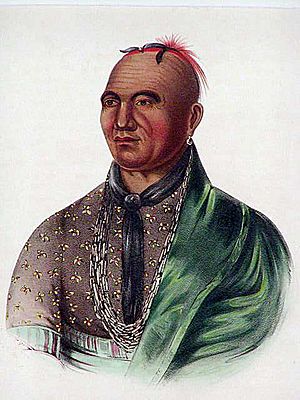
Joseph Brant died in his house at the head of Lake Ontario (site of what would become the city of Burlington, Ontario) on November 24, 1807, at age 64 after a short illness. His last words, spoken to his adopted nephew John Norton, reflect his lifelong commitment to his people: "Have pity on the poor Indians. If you have any influence with the great, endeavor to use it for their good."
In 1850, his remains were carried 34 miles (55 km) in relays on the shoulders of young men of Grand River to a tomb at Her Majesty's Chapel of the Mohawks in Brantford.
Legacy
Brant acted as a tireless negotiator for the Six Nations to control their land without Crown oversight or control.
Brant was a war chief, and not a hereditary Mohawk sachem. His natural ability, his early education, and the connections he was able to form made him one of the great leaders of his people and of his time.
His lifelong mission was to help the Indian to survive the transition from one culture to another, transcending the political, social and economic challenges of one of the most volatile, dynamic periods of American history. He put his loyalty to the Six Nations before loyalty to the British. His life cannot be summed up in terms of success or failure, although he had known both. More than anything, Brant's life was marked by frustration and struggle.
In more recent times, Brant's legacy has received debate due to his use of slave labour. Once African slavery was introduced into North America by European settlers, some Iroquois, such as Brant, did own African slaves.
Interesting facts about Joseph Brant
- At birth, he was named Thayendanegea, which in the Mohawk language means "He places two bets together". This came from the custom of tying the wagered items to each other when two parties placed a bet.
- His sister, Molly Brant, was the wife of Sir William Johnson, the influential British Superintendent of Indian Affairs in the province of New York.
- Brant's mother Margaret was a successful businesswoman who collected and sold ginseng, which was greatly valued for its medical qualities in Europe.
- In about 1772, Brant became Anglican, a faith he held for the remainder of his life.
- Aside from being fluent in English, Brant spoke at least three, and possibly all, of the Six Nations' Iroquoian languages.
- Brant was a Freemason.
Honors and memorialization
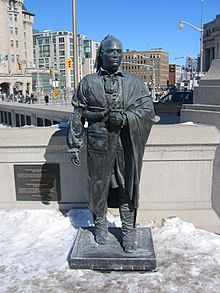
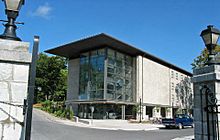
During his lifetime, Brant was the subject of many portrait artists. Two, in particular, signify his place in American, Canadian, and British history:
- George Romney's portrait, painted during Brant's first trip to England in 1775–76, hangs in the National Gallery of Canada in Ottawa, Ontario.
- The Charles Willson Peale portrait was painted during his visit to Philadelphia in 1797; it hangs in the art gallery in the former Second Bank of the United States building at Independence National Historical Park in Philadelphia. Brant chose to dress in traditional Mohawk style for the formal portraits.
- The Joseph Brant Museum was constructed the mid-1800s on land Brant once owned. An Ontario Historical Plaque was erected by the province to commemorate the Brant House's role in Ontario's heritage. His first house in Burlington was demolished in 1932.
- The City of Brantford and the County of Brant, Ontario, are located on part of his land grant and named for him. The town of Brant, New York was also named for him.
- Joseph Brant Hospital in Burlington, Ontario, is named for him; it is sited on land he had owned.
- A statue of Brant (1886) is located in Victoria Square, Brantford.
- The township of Tyendinaga and the Tyendinaga Mohawk Territory are named for him, by his traditional Mohawk name, in a different spelling.
- The neighbourhood of Tyandaga in Burlington was also named for him.
- Brant is one of the 14 leading Canadian military figures commemorated at the Valiants Memorial in Ottawa, Ontario.
- A dormitory and one of the squadrons at the Royal Military College of Canada are named for him.
Archaeology
In 1984–85, crews from The University at Albany under the direction of David Guldenzopf, supervised by Dean Snow investigated the late Mohawk site at "Indian Castle" (Dekanohage) in Herkimer County, New York. Among the structures excavated were a house owned by Molly Brant and her brother Joseph from around 1762–1780. The cellar had foundation walls of 60 centimetres (24 in) thickness with the floor 1 metre (3.3 ft) below the surface. The house was 6 by 12 metres (20 ft × 39 ft) with a wooden, rather than dirt, floor, and a gable-end fireplace rather than the standard central open fire and smoke hole. The outer walls were covered by clapboards. Following the Brants' forced departure the house was occupied by a white family until it burned down sometime between 1795 and 1820.
The site was designated a National Historic Landmark, the Mohawk Upper Castle Historic District, in 1993.
Alternative spellings
Brant signed his name in various ways, including:
- Tyendinaga
- Tyandaga
- Thayendanegea
- Thaienteneka
- Thayendanega
- Joseph Thayendanegea
- Joseph Brant
- Jos. Brant
- Brant
See also
 In Spanish: Joseph Brant para niños
In Spanish: Joseph Brant para niños


